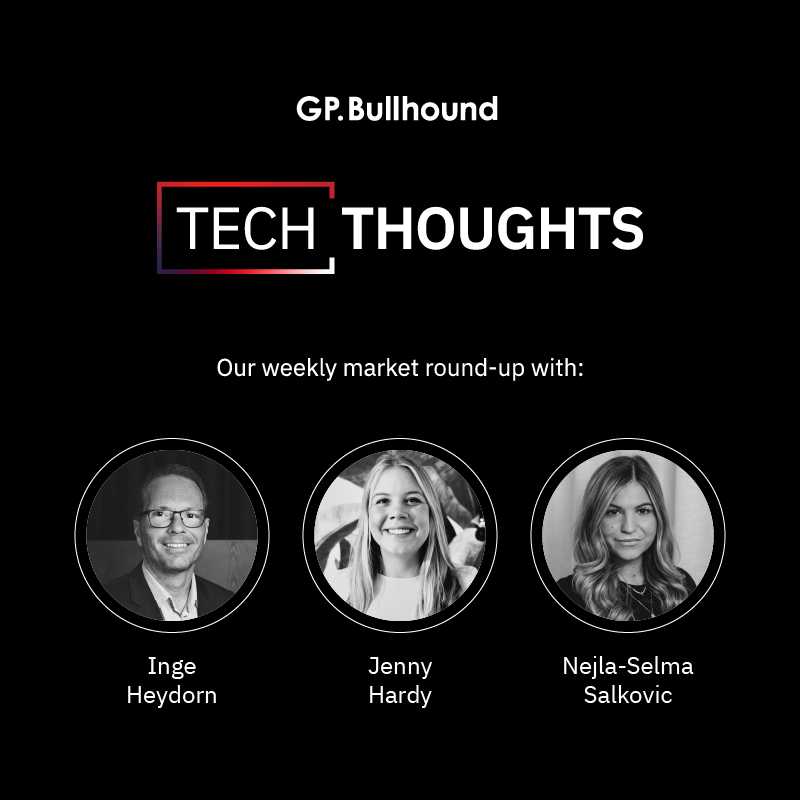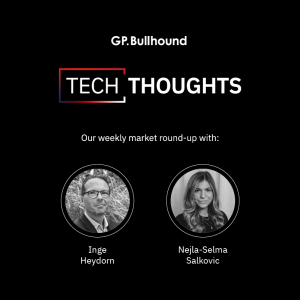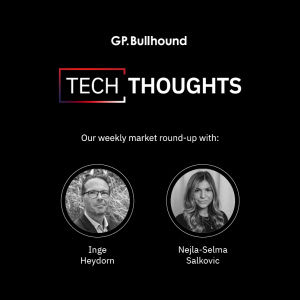Tech Thoughts Newsletter – 17 March 2023.

Market: All eyes have been on the banks this week after a number of smaller regional banks in the US suffered from falling deposits, at the same time as problems for Credit Suisse continue. In the US, the deposit guarantees have helped stem the losses, while the Swiss central bank loan guarantee has helped to stabilise CS. The stress in the banking system and mitigating actions taken has brought down interest rates which helped Tech outperform the market in general.
Portfolio: We bought some Infineon during the week as the company was underperforming the market while we continue to believe that underlying demand is strong.
Another week and more AI news flow – OpenAI released GPT-4. It actually turns out that the “new Bing” launched in Redmond on February 7th had been using GPT-4 model all along. The rate of tech change and announcements is pretty phenomenal (though Chat GPT-3 was initially launched in 2020) – and we continue to try to understand where the value around AI will accrue in the public markets.
We’ve talked over the past few weeks about the initial excitement of AI as a search use case subsiding, and the idea that the enterprise opportunity in AI is a much more obvious one, where existing enterprise software businesses can upsell AI features into their customer base.
Google this week announced new generative AI features in Google workspace. And yesterday Microsoft announced that its Office apps – Excel, PowerPoint, Outlook and Word, will begin using Open AI’s new GPT-4 AI platform. AI assistants called “Copilots” (we’re a bit sad the old “Clippy” the paperclip hasn’t been resurrected…) will be able to generate entirely new documents from scanning corporate files, chats and conference calls.
AI as an enterprise opportunity makes sense. Established enterprise software businesses who are able to (1) leverage very large installed bases to upsell AI features; (2) have large cash balances to invest in AI; (3) have the right business model for AI to match the increased cost – ie. subscription, not pay per click (like search).
Microsoft isn’t giving up on Bing noise (and is still causing a headache for Google) – as we said previously – it has nothing to lose. But for us it’s the opportunity to upsell and monetise AI across its half a billion Office users that is the more significant returns opportunity.
And as we commented last week – it’s an opportunity for all enterprise software businesses. And for enterprise software customers it makes much more sense to get AI capabilities via their existing platform software providers (Microsoft, Workday, ServiceNow, Salesforce can also benefit from upselling AI features) than to try to implement it themselves.
Next week we have Nvidia’s GTC event. So likely still no let-up in AI news flow!
On to other news:
Semicap – AMAT dividend and buyback showing the resilience of the sector
- The big news for us in the semis world this week was Applied Materials (AMAT, owned), who increased its quarterly dividend and announced a new $10bn buyback. It speaks to the cash generative nature of the sector (semicap equipment), even in a relatively subdued market spend environment. Management cited a “positive long-term view of the semis market”
- At its results last month it reported a 35% ROIC – helped by its tech leadership, scale, and sticky relationships with its semi manufacturing customers – in the fund we focus on those businesses with high return on invested capital and with an ability to sustain those returns over time.
- Semis and politics continued as TSMC’s founder Morris Chang was out in Taipei declaring “Globalisation is dead”. His frankness around the Chinese restrictions “I certainly support that part of American industrial policy to slow down China’s progress” surprised us a little! The Taiwan/China/US debate rumbles on..
- In more geopolitics, South Korea Ministry of Trade announced this week that it will support at least 10 fabless companies reach KRW1trn in sales by 2035, and help Samsung produce its AI and auto chips to enhance South Korea’s competitiveness in non-memory. The government is investing KRW300trn to build the world’s largest non-memory chip cluster in Yongin, which will house about 150 companies (both fabless and material/equipment suppliers).
- In addition, the government is going to focus on growing relationships between Samsung’s foundry business and domestic fabless companies. Total R&D support from the government will amount to KRW3.2trn (US$2.5bn), made up of KRW442bn in power chip, KRW665.3bn in auto and KRW2.1trn in AI. Not huge numbers but it speaks to the political will everywhere to build up more localised capabilities.
- Samsung also announced it will begin mass production of its 3rd generation 4nm chip in H1 23. We’ve known Samsung has had a challenging time trying to stabilise the yield of its easier 4nm process but this is improving and the new chip is better performance, lower power consumption and smaller area size vs. the last iteration – the tech leadership race continues.
Portfolio View – It’s pretty clear to us that we may be close to peak globalisation as it relates to chip manufacturing. That is part of what informs our positive view on semicap equipment – more localised fabs means more equipment, even if that might make very little sense economically (TSMC’s Arizona chips will cost ~40% more than its Hsinchu fabs).
Tech sovereignty, structural shortages at trailing edge nodes, and a technology leadership race in logic will all continue to drive spend in the sector this year.
More cost cutting announcements from big tech
- Meta announced an update to its “year of efficiency” in a company blog post, announcing a new round of cost cutting, with job cuts of ~10,000 people, as well as reducing job openings by ~5,000.
- This follows their full year results where they positively surprised around a bigger than expected capex and opex reduction.
- It expects to lower its annual expenses by roughly $3 billion from an estimated range it gave on Feb 1st. It now expects to spend a total of $86 billion to $92 billion this year, including the costs of its layoffs and restructuring.
- AI is still clearly in the realms of what Zuckerberg views as essential investment. It’s important to distinguish between Meta’s investment in AI as part of its core advertising business (as it attempts to mitigate some of the impacts from ATT), and the aspirations around the Metaverse – where there is no real tangible return.
- Apple (owned) is reported to be implementing a hiring freeze in certain parts of the company and delaying bonuses for some divisions in a cost cutting effort. Bonuses that normally are paid in April are moved to October. Apple has so far been cutting some contractors but held internal headcount – it remains the one big tech firm that hasn’t announced significant layoffs.
- Apple’s history has put it much closer to the brink than either Google or Facebook – it’s been through more cycles (and has been close to bankruptcy) and was born in a different time entirely. When Tim Cook came in he forced the business to focus on just 4 products – one desktop and one laptop for both consumers and professionals. Admittedly that product landscape has been expanded subsequently, and certainly under Tim Cook – but it remains a hugely focused business – and that speaks to the much lower pace of hiring/firing. It may also be the case that there’s a whole different degree of focus required to make a physical product.
Portfolio View – Tech as a whole is in a good position to cut opex further (helped by the high gross margins). But for us it’s hard to build an investment thesis around cost cutting. We don’t own Meta because we struggle to see how it can improve top line growth. Without that it’s very hard to turn this into a compounding returns thesis. A cost cutting thesis can only go so far and we view the runway for opex reduction as limited – given the spend on AI is in large part about mitigating the structural ATT issue and maintaining some competitive advantage.
Semis and AI
- Microsoft announced its “most powerful and scalable AI virtual machine (VM) series” – the ND H100v5 VM. This uses the latest Nvidia H100 chips (built on TSMC’s 4nm process) and Nvidia’s InfiniBand networking technology allowing even faster sharing for customers vs. the previous A100 based machine.
Portfolio View – we definitely view chips and infrastructure as an attractive part of the AI value chain. While business models at the application layer are still being figured out, there’s no getting away from how compute intensive these large language models are to run. GPT-4 and the number of parameters it uses is certainly much larger than GPT-3 (how much larger we don’t know). But that certainly means more processors, more memory and more compute needed to run it.
Adobe – executing well but the Figma deal still raises questions
- Adobe (owned) reported a very solid set of results – Historically Adobe has handled downturns in the economic environment reasonably well – the call definitely spoke to the secular trend towards digital continuing in spite of a more uncertain macro – and we expect roughly the same outcome this time around. Importantly, the company is also very profitable and generates a very good cashflow.
- The most interesting comments were probably around Figma where management highlighted the upsell opportunity and revenue synergies. We were sceptical around Figma at the time of the deal – and certainly the price paid. The bear case is that Adobe were losing (or had lost) mind-share in the collaboration space. While the business model was amongst the first to move to subscription, the problem for Adobe was that the product itself didn’t really change – it was still a disparate set of apps where Figma’s web based approach was much more suited to that design / collaboration environment, especially with the proliferation of apps where that becomes even more relevant. That’s why it’s important to Adobe now. Though that doesn’t mean that they can generate a return on invested capital that justifies the price paid.
Portfolio view – we own Adobe and view it as a relatively defensive software play. There are clearly question marks around whether this gets approved by the regulators – from our perspective we struggle to see how Adobe couldn’t invest organically at a higher rate of return than could be achieved by the deal.. We wait and see.
Content wars and price rises continue in streaming
- Google (owned) has had a few quarters with weaker top line in the YouTube business. The company is now trying to mitigate some of that weakness by raising monthly prices for its YouTube TV subscription. The monthly price is being revised from $64.99 previously to $72.99 effective April 18, 2023, according to an email sent to subscribers on Thursday from the company.
- “As content costs have risen and we continue to invest in the quality of our service, we are updating our price to keep bringing you the best possible service,” the company stated in the email to subscribers.
Portfolio view – we own Google and Disney. We have question-marks the long term returns within the streaming sector – but broadly price hikes is a positive sign of more rational and returns/profit focus. Content costs are increasing for all players and it’s clear that for big tech (Google, Amazon, Apple), they view streaming as strategic and are all competing meaningfully for content.
We also own Sony who are arguably the biggest winners in streaming – with its Pictures business benefiting from the bidding war for content!
Gaming – consolidation of spend in the key titles
- Another week at the top of the UK boxed charts for Warner Bros’ huge hit Hogwarts Legacy.
- It has also been No.1 in the weekly digital data, too. In fact, after just five weeks, the game has now surpassed the lifetime sales of Elden Ring in the UK (digital and physical).
- The reason for the comparison to Elden Ring is because the Bandai Namco game was last year’s major breakout hit, with sales only surpassed by FIFA 23, Call of Duty: Modern Warfare 2, GTA 5 and LEGO Star Wars: The Skywalker Saga by the end of 2022. In fact, Hogwarts Legacy will have surpassed LEGO Star Wars by the time the digital data arrives later this week.
- Hogwarts Legacy isn’t done, with the game set to arrive on PS4, Xbox One and Nintendo Switch in May and June.
Portfolio View: Gaming isn’t dead – though it is clearly being driven by the big hits. Title success is more broadly good news for the hardware cycles – The strong performance of Playstation is good news for Sony (owned) but also for AMD (owned) being sole supplier of the processor to Sony.
Elsewhere in AI – China’s Baidu releases its Chatbot
- Back to geopolitics, and it’s really China’s AI capability which the US restrictions focus on and really the US casts the restrictions fairly narrowly around the chips that are focused on AI capabilities. It is certainly the case that China have built a significant war chest around AI, and significant intellectual capacity (see the slide below from the State of AI report showing China’s academic leadership)
- Baidu (not owned) launched their AI solution ERNIEbot, its chatbot based on a large language model, and claimed it represents “a reinvention of computing”.
- 50 billion facts were used to train the model.
- Robin Li, Baidu Co-founder said: “Baidu envisions a future where we join forces with all to drive the evolution of AI, empowering every individual with access to state-of-the-art productivity tools and ensuring that the benefits of these advancements are shared by all.”
- 30,000 business clients signed up for access to the chatbot’s waitlist within an hour of the Ernie bot’s introduction.
- In a presentation in Chinese, Baidu described current computing paradigms as relying on three layers – a processor, an operating system, and an application layer.
- Baidu believes computing is now moving to a stack that starts with a CPU and/or GPU, with a deep learning framework like Baidu’s own Paddlepaddle machine learning framework in the next tier up.
- Tier three is models like the “Big Model” that powers ERNIE, with an application layer on top of the stack.
Portfolio view – we don’t own any of the Chinese internet stocks given the uncertainty around regulation. Nevertheless we acknowledge how much IP the Chinese internet businesses have built on the space. Despite the restrictions around AI chips, China remains a significant market for cloud and AI infrastructure – after the restrictions, Nvidia released a “China GPU chip” which effectively slows it down to a point where it meets the US export restrictions. So from that perspective, again, the chip infrastructure side will continue to benefit from these sorts of developments.
For weekly insights on the latest market updates, please subscribe to our Tech Thoughts podcast.
For more information about the latest trends and forecasts, please visit our official Tech Thoughts page.
We provide investors with access to category leading technology companies, globally. Our assets under management have a total value of more than $1bn, and our limited partners include institutions, family offices and entrepreneurs. Learn more about our funds here.
Enquiries
For enquiries, please contact:
Inge Heydorn, Partner, at inge.heydorn@gpbullhound.com
Jenny Hardy, Portfolio Manager, at jenny.hardy@gpbullhound.com
Nejla-Selma Salkovic, Analyst, at nejla-selma.salkovic@gpbullhound.com
About GP Bullhound
GP Bullhound is a leading technology advisory and investment firm, providing transaction advice and capital to the world’s best entrepreneurs and founders. Founded in 1999 in London and Menlo Park, the firm today has 13 offices spanning Europe, the US and Asia. For more information, please visit www.gpbullhound.com.

